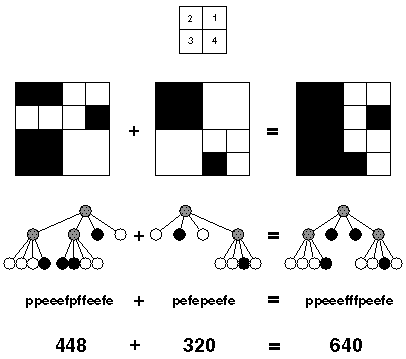
Of course, if the whole image is a single color, it can be represented by a quadtree consisting of a single node. In general, a quadrant needs only to be subdivided if it consists of pixels of different colors. As a result, the quadtree need not be of uniform depth.
A modern computer artist works with black-and-white images of 32×32 units, for a total of 1024 pixels per image. One of the operations he performs is adding two images together, to form a new image. In the resulting image a pixel is black if it was black in at least one of the component images, otherwise it is white.
This particular artist believes in what he calls the preferred fullness: for an image to be interesting (i.e. to sell for big bucks) the most important property is the number of filled (black) pixels in the image. So, before adding two images together, he would like to know how many pixels will be black in the resulting image. Your job is to write a program that, given the quadtree representation of two images, calculates the number of pixels that are black in the image, which is the result of adding the two images together.
In the figure, the first example is shown (from top to bottom) as image, quadtree, pre-order string (defined below) and number of pixels. The quadrant numbering is shown at the top of the figure.

p'
indicates a parent node, the letter 'f' (full) a black
quadrant and the letter 'e' (empty) a white quadrant. It
is guaranteed that each string represents a valid quadtree, while the
depth of the tree is not more than 5 (because each pixel has only one
color).
There are
X black pixels.', where X is the number of
black pixels in the resulting image.
3 ppeeefpffeefe pefepeefe peeef peefe peeef peepefefe
There are 640 black pixels. There are 512 black pixels. There are 384 black pixels.